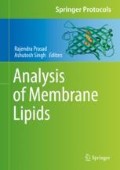Abstract
Sphingolipids are a major class of bioactive structural lipids that also play diverse roles in signaling events in different disease conditions like cancer. They form a dynamic metabolic network, and alterations in their metabolism are known to contribute to progression of the disease. Therefore, quantitation of these metabolites from mammalian cells as a disease model system can provide us a vivid picture of the regulatory nodes in the pathway that can be targeted to identify sphingolipid-based biomarkers or targets for future therapies. Herein, we present a simple, sensitive, and robust method to simultaneously quantitate sphingolipids of the early steps of the metabolic pathway by a liquid chromatography–mass spectrometry-based method using mammalian cells as model system.
Access this chapter
Tax calculation will be finalised at checkout
Purchases are for personal use only
References
Hannun YA, Obeid LM (2018) Sphingolipids and their metabolism in physiology an disease. Nat Rev Mol Cell Biol 19(3):175–191
Ogretmen B (2018) Sphingolipid metabolism in cancer signalling and therapy. Nat Rev Cancer 18:33–50
Ryland LK, Fox TE, Liu X, Loughran TP, Kester M (2011) Dysregulation of sphingolipid metabolism in cancer. Cancer Biol Ther 11(2):138–149
Pyne NJ, Pyne S (2010) Sphingosine 1-phosphate and cancer. Nat Rev Cancer 10(7):489–503
Ogretmen B, Hannun YA (2004) Biologically active sphingolipids in cancer pathogenesis and treatment. Nat Rev Cancer 4(8):604–616
Shaw J, Costa-Pinheiro P, Patterson L, Drews K, Spiegel S, Kester M (2018) Novel sphingolipid-based cancer therapeutics in the personalized medicine era. Adv Cancer Res 140:327–366
Bielawski J, Szulc ZM, Hannun YA, Bielawska A (2006) Simultaneous quantitative analysis of bioactive sphingolipids by high-performance liquid chromatography-tandem mass spectrometry. Methods 39:82–91
Scherer M, Leuthäuser-Jaschinski K, Ecker J, Schmitz G, Liebisch G (2010) A rapid and quantitative LC-MS/MS method to profile sphingolipids. J Lipid Res 51:2001–2011
Merrill AH Jr, Sullards MC, Allegood JC, Kelly S, Wang E (2005) Sphingolipidomics: high-throughput, structure-specific, and quantitative analysis of sphingolipids by liquid chromatography tandem mass spectrometry. Methods 36:207–224
Nunes J, Naymark M, Sauer L, Muhammad A, Keun H, Sturge J, Stebbing J, Waxman J, Pchejetski D (2012) Circulating sphingosine-1-phosphate and erythrocyte sphingosine kinase-1 activity as novel biomarkers for early prostate cancer detection. Br J Cancer 106(5):909–915
Pyne S, Edwards J, Ohotski J, Pyne NJ (2012) Sphingosine 1-phosphate receptors and sphingosine kinase 1: novel biomarkers for clinical prognosis in breast, prostate, and hematological cancers. Front Oncol 2:168
Shaner RL, Allegood JC, Park H, Wang E, Kelly S, Haynes CA, Sullards MC, Merrill AH Jr (2009) Quantitative analysis of sphingolipids for lipidomics using triple quadrupole and quadrupole linear ion trap mass spectrometers. J Lipid Res 50:1692–1707
Dasgupta U, Bamba T, Chiantia S, Karim P, Tayoun AN, Yonamine I, Rawat SS, Rao RP, Nagashima K, Fukusaki E, Puri V, Dolph PJ, Schwille P, Acharya JK, Acharya U (2009) Ceramide kinase regulates phospholipase C and phosphatidylinositol 4, 5, bisphosphate in phototransduction. Proc Natl Acad Sci USA 106:20063–20068
Acknowledgments
The support from Amity University Haryana, India is acknowledged. U.D. is supported by BT/PR19624/BIC/101/488/2016 (DBT) and ECR/2016/001603 (DST). Amity Lipidomics Research Facility at Amity University Haryana is supported by DST-FIST grant SR/FST/LSI-664/2016.
Author information
Authors and Affiliations
Corresponding author
Editor information
Editors and Affiliations
Rights and permissions
Copyright information
© 2020 Springer Science+Business Media, LLC, part of Springer Nature
About this protocol
Cite this protocol
Medatwal, N., Dasgupta, U. (2020). Quantitation of Sphingolipids in Mammalian Cell Lines by Liquid Chromatography–Mass Spectrometry. In: Prasad, R., Singh, A. (eds) Analysis of Membrane Lipids. Springer Protocols Handbooks. Springer, New York, NY. https://doi.org/10.1007/978-1-0716-0631-5_7
Download citation
DOI: https://doi.org/10.1007/978-1-0716-0631-5_7
Published:
Publisher Name: Springer, New York, NY
Print ISBN: 978-1-0716-0630-8
Online ISBN: 978-1-0716-0631-5
eBook Packages: Springer Protocols

